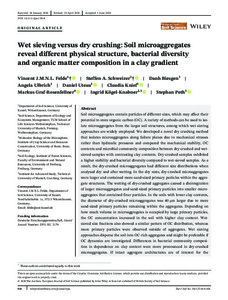| dc.date.accessioned | 2021-03-12T16:08:25Z | |
| dc.date.available | 2021-03-12T16:08:25Z | |
| dc.date.issued | 2020-06-18 | |
| dc.identifier | doi:10.17170/kobra-202103043417 | |
| dc.identifier.uri | http://hdl.handle.net/123456789/12634 | |
| dc.description.sponsorship | Gefördert im Rahmen des Projekts DEAL | ger |
| dc.language.iso | eng | eng |
| dc.rights | Namensnennung 4.0 International | * |
| dc.rights.uri | http://creativecommons.org/licenses/by/4.0/ | * |
| dc.subject | aggregate breakdown dynamics | eng |
| dc.subject | aggregate carbon | eng |
| dc.subject | aggregate separation | eng |
| dc.subject | aggregate stability | eng |
| dc.subject | aggregation | eng |
| dc.subject | microaggregate | eng |
| dc.subject | microbial community structure | eng |
| dc.subject | SOM distribution | eng |
| dc.subject.ddc | 333 | |
| dc.subject.ddc | 570 | |
| dc.title | Wet sieving versus dry crushing: Soil microaggregates reveal different physical structure, bacterial diversity and organic matter composition in a clay gradient | eng |
| dc.type | Aufsatz | |
| dcterms.abstract | Soil microaggregates contain particles of different sizes, which may affect their potential to store organic carbon (OC). A variety of methods can be used to isolate microaggregates from the larger soil structures, among which wet sieving approaches are widely employed. We developed a novel dry crushing method that isolates microaggregates along failure planes due to mechanical stresses rather than hydraulic pressures and compared the mechanical stability, OC contents and microbial community composition between dry‐crushed and wet‐sieved samples with contrasting clay contents. Dry‐crushed samples exhibited a higher stability and bacterial diversity compared to wet‐sieved samples. As a result, the dry‐crushed microaggregates had different size distributions when analysed dry and after wetting. In the dry state, dry‐crushed microaggregates were larger and contained more sand‐sized primary particles within the aggregate structures. The wetting of dry‐crushed aggregates caused a disintegration of larger microaggregates and sand‐sized primary particles into smaller microaggregates that contained finer particles. In the soils with lower clay contents, the diameter of dry‐crushed microaggregates was 40 μm larger due to more sand‐sized primary particles remaining within the aggregates. Depending on how much volume in microaggregates is occupied by large primary particles, the OC concentration increased in the soil with higher clay content. Wet‐sieved size fractions also showed a similar pattern of OC distribution, whereas more primary particles were observed outside of aggregates. Wet sieving approaches disperse the soil into OC‐rich aggregates and might be preferable if OC dynamics are investigated. Differences in bacterial community composition in dependence on clay content were more pronounced in dry‐crushed microaggregates. If intact aggregate architectures are of interest for the isolation of soil structural units, the presented dry crushing method might provide an advantageous alternative that also better preserves bacterial diversity. | eng |
| dcterms.accessRights | open access | |
| dcterms.creator | Felde, Vincent John Martin Noah Linus | |
| dcterms.creator | Schweizer, Steffen A. | |
| dcterms.creator | Biesgen, Danh | |
| dcterms.creator | Ulbrich, Angela | |
| dcterms.creator | Uteau, Daniel | |
| dcterms.creator | Knief, Claudia | |
| dcterms.creator | Graf-Rosenfellner, Markus | |
| dcterms.creator | Kögel-Knabner, Ingrid | |
| dcterms.creator | Peth, Stephan | |
| dc.relation.doi | doi:10.1111/ejss.13014 | |
| dc.relation.projectid | Grant/Award Number: DFG RU 2179 | |
| dc.subject.swd | Bodenbestandteil | ger |
| dc.subject.swd | Bodenbakterien | ger |
| dc.subject.swd | Sieben <Verfahrenstechnik> | ger |
| dc.subject.swd | Zerkleinern | ger |
| dc.subject.swd | Bodenmikroorganismus | ger |
| dc.type.version | publishedVersion | |
| dcterms.source.identifier | EISSN 1365-2389 | |
| dcterms.source.issue | Issue 2 | |
| dcterms.source.journal | European Journal of Soil Science (EJSS) | eng |
| dcterms.source.pageinfo | 810-828 | |
| dcterms.source.volume | Volume 72 | |
| kup.iskup | false | |



